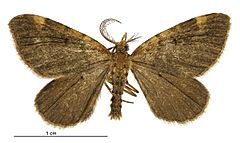Asaphodes chlorocapna facts for kids
Quick facts for kids Asaphodes chlorocapna |
|
|---|---|
 |
|
| Male | |
| Scientific classification | |
| Kingdom: | |
| Phylum: | |
| Subphylum: | |
| Class: | |
| Order: | |
| Family: | |
| Genus: |
Asaphodes
|
| Species: |
A. chlorocapna
|
| Binomial name | |
| Asaphodes chlorocapna (Meyrick, 1925)
|
|
| Synonyms | |
|
|
The Asaphodes chlorocapna is a type of moth that belongs to the Geometridae family. This special moth lives only in New Zealand. It is considered "At Risk, Relict" by the Department of Conservation, which means it needs protection.
Contents
About This Moth
How It Got Its Name
This moth was first described in 1925 by a scientist named Edward Meyrick. He called it Xanthorhoe chlorocapna. He studied a specimen collected by Stewart Lindsay from Mangere Island in the Chatham Islands. Later, in 1987, another scientist, R. C. Craw, moved this moth to the group of moths called Asaphodes. The original specimen used to describe the moth is kept at the Canterbury Museum.
What It Looks Like
Male Asaphodes chlorocapna moths are about 24 to 26 millimeters wide when their wings are spread out. Their heads, mouthparts, and bodies are a pale grayish-yellow color with tiny black specks. Their front wings are light smoky-grey with dark brown specks. The outer edge of the wing is slightly curved. There's a small, dark brown spot in the middle of the wing. The fringes of hair along the wing edges are whitish, but the part closest to the wing is dark grey. Their back wings are dark grey, with whitish fringes that are grey closer to the wing.
Where It Lives
This moth is found only in New Zealand. Specifically, it lives on the Chatham Islands. You can find it on Mangere Island, Pitt Island, and Rangatira Island.
Life Cycle and Habits
Adult Asaphodes chlorocapna moths can be seen flying around in January.
What It Eats
The young moths, called larvae, eat the fallen leaves of plants from the Muehlenbeckia family.
Its Conservation Status
This moth is listed under the New Zealand Threat Classification System. It is classified as "At Risk, Relict." This means it's a species that is not doing well and needs help to survive in the wild.
Images for kids


